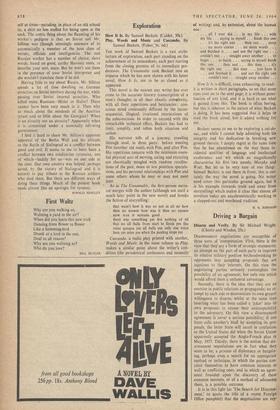Exploration
THE work of Samuel Beckett is a vast archi- tecture of exploration, each part standing on the achievement of its antecedents, each part starting from the closing premise of its immediate pre- decessor. The Unnamable took Beckett into an impasse which he has now shown with his latest novel, How It Is, not to be as closed as it appeared.
This novel is the nearest any writer has ever come to the accurate literary transcription of a man's thoughts in all their chaotic complexity, with all their repetitions and hesitancies: con- scious mind continually diffused by the incon- sequential, illogical, irrational interjections of the subconscious. In order to succeed with this remarkable techtaical effect, Beckett has had to limit, simplify, and • refine both situation and action.
His narrator tells of a journey, crawling through mud, in three parts: before meeting Pim (another old man),. with Pim, and after Pim. His repetitious concern with the minimum essen- tial physical acts of moving, eating and excreting are chaotically mingled with random recollec- tions of the past, more or less pointless specula- tions, and his personal relationships with Pim and some others whom he may or may not meet later.
As in The Unnamable, the first-person narra- tor-merges with the author (although not until a much later point in the new novel) and breaks the fiction of storytelling: , that wasn't how it was no not at all no bow then no answer how was it then no answer HOW WAS rt screams good there was something yes but nothing of all that no all balls from start to finish yes this voice quaqua yes all balls yes only one voice here yes mine yes when the panting stops yes Cascando, a radio play printed with another, Words and Music, in the same volume as Play, makes a similar point about the writer's con- dition (the paradoxical uselessness and necessity
of writing) and, by extension, about the human one: . . . all I ever did . . . in my life . . . with my life ... saying to myself ... finish this one . . . it's the right one . . . then rest . . . sleep . . . no more stories . . . no more words . . . and finished it . . . and not the right one . . . couldn't rest . . . straight away another . . • to begin . . to finish . . . saying to myself finish this one . . . then rest . . . this time . . . it's the right one . . . this time . . . you have it . . . and finished it . . . and not the right one . . . couldn't rest ... straight away another ...
How It Is is difficult, even exhausting, to read: it is written in short paragraphs, so set that none runs over on to the next page; it is without punc- tuation of any kind, and it is hard to see what is gained from this. The book is often boring, but this is inherent in the nature of what Beckett is doing. It has been suggested that it helps to read the book aloud, but it added nothing for me.
Beckett seems to me to be exploring a cul-de- sac, .and while I cannot help admiring both his integrity and his dedication in breaking new ground therein, I deeply regret at the same time that he has abandoned on the way those in- cidental qualities of language and intellectual exuberance and wit which so magnificently characterise his first two novels, Murphy and Watt. But let us be very sure of one thing: Samuel Beckett is out there in front, this is cer- tainly the way the novel is going. No writer need cover this particular ground again, but it is his example (towards truth and away from storytelling) which makes it clear that almost all novelists today are anachronistically working in a clapped-out and moribund tradition.
B. S. JOHNSON


































 Previous page
Previous page